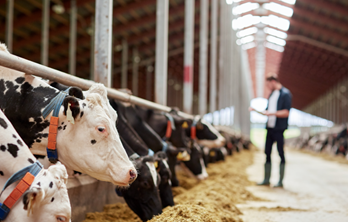Is D-Methionine the only D-Amino Acid to be converted into the L-Form?
2020.03.17

Introduction
Methionine is the first limiting amino acid (AA) in poultry and one of the first limiting amino acids in other species. DL-methionine became commercially available and became a popular source of methionine after being shown that it is more efficient than the liquid form (Sauer et al. 2008). It was believed that D-methionine is 90% converted to L-methionine and that DL-methionine is 95% bioavailable (Baker, 1994) although there were clear data about DL-methionine being excreted at 10% and being oxidized at 5.5 % (Saunderson, 1985 and 1987). Saunderson works did not get enough attention because L-methionine was not commercially available. Nevertheless, L-methionine became commercially available in 2014 as the only natural source of methionine. L-methionine can be directly utilized for growth and physiological needs (a game changer for the industry). L-methionine is available in high volumes
produced from renewable resources. Crystalline L-methionine provides the opportunity of relieving farm animals from the unnecessary job to convert the isomers and precursors of methionine to L-methionine.
The question is: if farm animals have to convert only D-methionine to the L-form?
D-amino acids exists in plants up to 8% of the corresponding L-forms
It is a widely accepted fact that plants harbor free D-AAs as they could be identified in different plant species and tissues (Kolukisaoglu and Suarez, 2017). Free D-AAs in the range of about 0.2% up to 8% relative to the corresponding L-AAs were found in plants (Bruckner and Westhauser, 2003).
Processing (heating, alkaline, and acid treatment) increases the content of D-amino acids
Processing increases the content of D-AAs (Caspo et al. 2009). Some insects, worms and marine invertebrates also contain substantial
quantities of D-AAs (Caspo et al. 2009), for example, quantities of D-AAs occurring in marine shellfish can e xceed 1%. On examination of free D-AAs in milk, fermented milk, fresh cheese and curd cheese, Bruckner and Hausch (1990) established that considerable quantities of D-AAs occur both in raw milk and in fermented dairy products manufactured from it. The empirical data obtained by the above authors are presented in Table 1.
%20increases%20the%20content%20of%20D-amino%20acids.jpg)
Feed industry uses a mixture of different processing technologies such as pelleting, extrusion, pressure, etc. Similar to the food industry. Table 2 gives the D-AA content of various processed foodstuffs in comparison with untreated controls. Heat treatment or combined heat and alkali treatment in every case gave rise to D-AAs in measurable quantities.
The highest D-aspartic acid content (31%) was determined in the casein heated to 230 °C for 20 minutes.
Conclusion
Plants contain D-form of AAs and feed processing makes the content of D-AAs even higher. Thus, there is a hidden pressure on the enzymatic machinery which are supposed to convert D-AAs to the L-form. The question is why one should exert an additional pressure to the cellular system of farm animals in order to convert D-methionine to L-methionine. Farm animals already have a high metabolic rate because of their fast growth. Nutritionists can reduce the stress on the farm animals by means of using a commercially available L-methionine.
To answer the question at the beginning of this article: farm animals have to convert not only D-methionine to the L-form but also other D-AAs which does exists in the plants or the ones in which their concentrations are increased because of processing the raw materials or complete feed.

References
1. Baker, D.H. 1994. Utilization of precursors for L-amino acids. In: DMello, J.P.F. (ed.) Amino Acids in Farm Animal Nutrition. CAB International, Wallingford, UK, pp. 3761.
2. Brü ckner, H. and M. Hausch. 1990. D-amino acids in dairy products: Detection, origin and nutritional aspects. I. Milk, fermented milk, fresh cheese and acid curd cheese. Milchwissenschaft. 45: 357-360.
3. Brü ckner, H. and T. Westhauser. 2003. Chromatographic determination of L- and D-amino acids in plants. Amino Acids. 24:4355.
4. Csapo, J. , Albert, Cs. and Zs. Csapo-Kiss. 2009. The D-amino acid content of foodstuffs (A Review). Acta Univ. Sapientiae, Alimentaria, 2(1) 5-30.
5. Kolukisaoglu, ü . and J. Suarez. 2017. D-Amino Acids in Plants: New Insights and Aspects, but also More Open Questions. doi.org/10.5772/intechopen.68539.
6. Sauer, N., K. Emrich, H.-P. Piepho, A. Lemme, M. S. Redshaw, and R. Mosenthin. 2008. Meta-Analysis of the Relative Efficiency of Methionine-Hydroxy-Analogue-Free-Acid Compared with dl-Methionine in Broilers Using Nonlinear Mixed Models. Poultry Science 87:20232031.
7. Saunderson, C.L. 1985. Comparative metabolism of L-Methionine, DL-Methionine and DL-2-hydrox4y-m ethylthiobutanoic acid by broiler chicks. Br. J. Nutr. 54:621-633.
8. Saunderson, C.L. 1987. Effect of fasting and of methionine deficiency on L-Methionine, DL-Methionine and DL-2-hydroxy-4-methylthiobutanoic acid metabolism in broiler chicks. Br. J. Nutr. 57:429-437.























